Yushima Seidō
Yushima Seidō[1] (湯島聖堂, literally "Yushima Sage Hall"), located in the Yushima neighbourhood of Bunkyō, Tokyo, Japan, was established as a Confucian temple in the Genroku era of the Edo period (end of the 17th century).
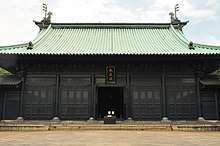
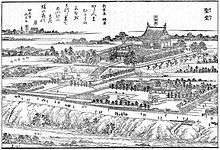
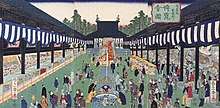
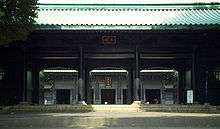
Tokugawa bureaucrat training center
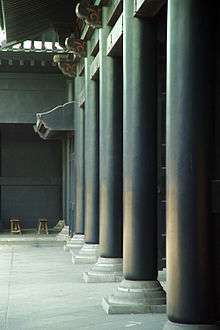
The Yushima Seidō has its origins in a private Confucian temple, the Sensei-den (先聖殿), constructed in 1630 by the neo-Confucian scholar Hayashi Razan (1583–1657) in his grounds at Shinobu-ga-oka (now in Ueno Park). The fifth Tokugawa shōgun, Tsunayoshi, moved the building to its present site in 1690, where it became the Taiseiden (大成殿) of Yushima Seidō. The Hayashi school of Confucianism moved at the same time.
Under the Kansei Edict, which made neo-Confucianism the official philosophy of Japan, the Hayashi school was transformed into a state-run school under the control of the shogunate in 1797. The school was known as the Shōhei-zaka Gakumonjo (昌平坂学問所) or Shōheikō (昌平黌), after the supposed birthplace of Confucius (昌平, pronounced Shōhei in Japanese). During the time of the Tokugawa shogunate, the school attracted many men of talent, but it was closed in 1871 after the Meiji Restoration.
Daigaku-no-kami
The title Daigaku-no-kami identifies the head of the chief educational institution of the state. It was conferred by the shogun in 1691 when the Neo-Confucian academy moved to land provided by the shogunate at Yushima. In the years which followed, this academic title became hereditary for the ten descendants who followed in succession.[2]
In the early years of the Edo period, the seidō or Confucian "Hall of Sages" was located in Shinobugaoka; but in 1691, it was moved to a new location at the top of a hill in the Yushima section of Edo.[3] The hereditary heads of the Edo daigaku are identified below.
- Founder: Hayashi Razan (1583–1657), formerly Hayashi Nobukatsu, also known as Dōshun (1st son of Nobutoki).[4]
- Son of founder: Hayashi Gahō (1618–1688), formerly Hayashi Harukatsu (3rd son of Razan).[5]
- 1st rector (and Daigaku-no-kami): Hayashi Hōkō (1644–1732), formerly Hayashi Nobuhatsu (son of Gahō).[3]
- 2nd rector (and Daigaku-no-kami): Hayashi Ryūkō (1681–1758).
- 3rd rector (and Daigaku-no-kami): Hayashi Hōkoku (1721–1773).
- 4th rector (and Daigaku-no-kami): Hayashi Hōtan (1761–1787).
- 5th rector (and Daigaku-no-kami): Hayashi Kimpō (1767–1793), also known as Hayashi Kanjun or Hayashi Nobutaka[6]
- 6th rector and 8th Daigaku-no-kami): Hayashi Jussai (1768–1841), formerly Matsudaira Norihira, 3rd son of Iwamura daimyō Matsudaira Norimori—Norihira was adopted into Hayashi family when Kimpō/Kanjun died childless; explained shogunate foreign policy to Emperor Kōkaku in 1804.,[7] also known as Hayashi Jitsusai[8] and Hayashi Kō.[6]
- 7th rector (and Daigaku-no-kami): Hayashi Teiu (1791–1844).
- 8th rector (and Daigaku-no-kami): Hayashi Sōkan (1828–1853).
- 9th rector (and Daigaku-no-kami): Hayashi Fukusai (1800–1859), also known as Hayashi Akira, chief Japanese negotiator for the Treaty of Kanagawa[9]
- 10th rector (and Daigaku-no-kami): Hayashi Gakusai (1833–1906), formerly Hayashi Noboru, head of the academy in 1867.
Yushima Seidō's notable alumni and academics
- Saitō Chikudō (1815–1852)
Institutional history after 1871
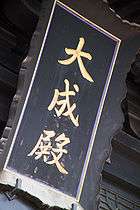
Since the Meiji restoration, Yushima Seidō has temporarily shared its premises with a number of different institutions, including the Ministry of Education, the Tokyo National Museum, and the forerunners of today’s Tsukuba University and Ochanomizu University (which is now in a different location but retains "Ochanomizu" in its name).
The site of the school is now occupied by the Tokyo Medical and Dental University.
The colour scheme of the original Taiseiden is believed to have been one of vermilion paint with verdigris. After being burnt down on a number of occasions, the Taiseiden was rebuilt in 1799 in the style of the Confucian temple in Mito, which used black paint. This building survived through the Meiji period and was designated a national historical site in 1922, but was burnt down in the Great Kantō earthquake of the following year. The current Taiseiden is in reinforced concrete and was designed by Itō Chūta.
Inside the compound is the world's largest statue of Confucius, donated in 1975 by the Lions Club of Taipei, Taiwan. There are also statues of the Four Sages, Yan Hui, Zengzi, Kong Ji, and Mencius.
In the 1970s, the Taiseiden was used as the location for scenes in NTV's Monkey television series.
Along with the nearby Yushima Tenman-gū, the Yushima Seidō is a mecca for students praying for success in their examinations.
Transportation
Ochanomizu Station and Shin-Ochanomizu Station are nearby.
See also
- Zhu Xi (Chu Hsi) – neo-Confucianist teacher
- Fujiwara Seika – Japanese disciple of Zhu Xi
- Hayashi clan (Confucian scholars)
References
Citations
- Patricia Jane Graham (2007). Faith and Power in Japanese Buddhist Art, 1600-2005. University of Hawaii Press. pp. 200–. ISBN 978-0-8248-3191-2.
- Kelly, Boyd. (1999). Encyclopedia of Historians and Historical Writing, Vol. 1, p. 522; De Bary, William et al. (2005). Sources of Japanese Tradition, Vol. 2, p. 69.
- De Bary, p. 443.
- Screech, Timon. (2006). Secret Memoirs of the Shoguns: Isaac Titsingh and Japan, 1779–1822, p. 65; Cullen, L.M. (2003). A History of Japan, 1582–1941: Internal and External Worlds, p. 59.
- Screech, p. 65.
- Nussbaum, Louis Frédéric et al. (2005). Japan Encyclopedia, p. 300.
- Cullen, pp. 117, 163.
- Asiatic Society of Japan. (1908). Transactions of the Asiatic Society of Japan, v36:1(1908), p. 151.
- Cullen, p. 178 n11.
Bibliography
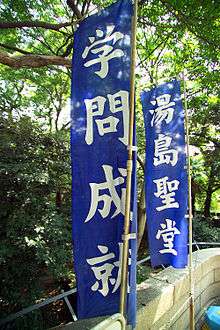
- Brownlee, John S. (1997) Japanese historians and the national myths, 1600–1945: The Age of the Gods and Emperor Jimmu. Vancouver: University of British Columbia Press. ISBN 978-0-7748-0644-2 Tokyo: University of Tokyo Press. ISBN 978-4-13-027031-1
- Brownlee, John S. (1991). Political Thought in Japanese Historical Writing: From Kojiki (712) to Tokushi Yoron (1712). Waterloo, Ontario: Wilfrid Laurier University Press. ISBN 978-0-88920-997-8
- Cullen, Louis .M. (2003). A History of Japan, 1582–1941: Internal and External Worlds. Cambridge: Cambridge University Press. ISBN 978-0-521-82155-1 (cloth) ISBN 978-0-521-52918-1 (paper)
- De Bary, William Theodore, Carol Gluck, Arthur E. Tiedemann. (2005). Sources of Japanese Tradition, Vol. 2. New York: Columbia University Press. ISBN 978-0-231-12984-8 OCLC 255020415
- Kelly, Boyd. (1999). Encyclopedia of Historians and Historical Writing, Vol. 1. London: Taylor & Francis. ISBN 978-1-884964-33-6
- Nussbaum, Louis Frédéric and Käthe Roth. (2005). Japan Encyclopedia. Cambridge: Harvard University Press. ISBN 978-0-674-01753-5 OCLC 48943301
- Ponsonby-Fane, Richard A. B. (1956). Kyoto: The Old Capital of Japan, 794–1869. Kyoto: The Ponsonby Memorial Society. OCLC 36644
- Screech, Timon. (2006). Secret Memoirs of the Shoguns: Isaac Titsingh and Japan, 1779–1822. London: RoutledgeCurzon. ISBN 978-0-7007-1720-0.
- Yamashita, Samuel Hideo. "Yamasaki Ansai and Confucian School Relations, 1650–1675" in Early Modern Japan, (Fall 2001). Ann Arbor: University of Michigan Press.
External links
![]()